A Theology of the Force – Part 2
This is a continuation of an essay analysis of the Force from Star Wars and The Empire Strikes Back. If you have not, read A Theology of the Force – Part 1 before continuing with this article.
Also, a quick note on sources for Part 2. I am indebted to the work of John C. McDowell in his book, The Gospel According to Star Wars; James Harleman’s Star Wars series at Cinemagogue; and a cool breakdown of some biblical lessons from Yoda from Tony Feagin’s blog. All three sources were extremely helpful to stir the pot as I watched and re-watched ESB.
The first time we are introduced to the concept of the Force, and the first uses of the Force, are on the backwater, desert planet of Tatooine. There the once great Jedi Knight Obi-Wan Kenobi meets the son of his former pupil, Anakin Skywalker. Obi-Wan regales young Luke with tales of the Jedi Knights, guardians of peace and justice for over a thousand generations throughout the galaxy, and their mysterious ally; the mystical life-giving Force.
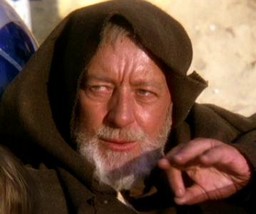 Later on, after Luke makes the tragic discovery of his aunt and uncle’s burned corpses—perpetrated by Imperial Stormtroopers at the behest of Darth Vader—Obi-Wan, Luke, R2-D2, and C-3PO travel to Mos Eisley to find a safe passage to Alderaan, the home planet of imprisoned Rebel, Princess Leia. As Luke’s X-34 Landspeeder caroms among the dusty hovels of Mos Eisley spaceport, they are stopped by more white-armored Stormtroopers for questioning. What should have proved an untimely end to their journey was Luke’s first opportunity to see the Force in action. Obi-Wan, using the Force on weak-minded stormtroopers, wills them to ignore the droids in their possessions and allow them to pass.
Later on, after Luke makes the tragic discovery of his aunt and uncle’s burned corpses—perpetrated by Imperial Stormtroopers at the behest of Darth Vader—Obi-Wan, Luke, R2-D2, and C-3PO travel to Mos Eisley to find a safe passage to Alderaan, the home planet of imprisoned Rebel, Princess Leia. As Luke’s X-34 Landspeeder caroms among the dusty hovels of Mos Eisley spaceport, they are stopped by more white-armored Stormtroopers for questioning. What should have proved an untimely end to their journey was Luke’s first opportunity to see the Force in action. Obi-Wan, using the Force on weak-minded stormtroopers, wills them to ignore the droids in their possessions and allow them to pass.
Not only is it Luke’s first experience, but it is our first on-screen look at the power of Obi-Wan the Jedi Knight and the power of the Force. However, from an on-screen usage within the first film, the Force is principally used as a plot device with the same mantra as the weak-minded Stormtrooper; to “move along” Luke’s story or the overall narrative. It is a magic power to allow them to get off world, to distract more Stormtroopers, to keep our hero alive, and to let him deliver the final blow to the Empire’s planet-destroying Death Star. Lucas has admitted as much over the years since Star Wars; the Force is often merely functional to give some characters super-human abilities in order to project fear, in Darth Vader’s case, or to achieve an important goal, like Obi-Wan and Luke.
But Lucas not only used the superhuman giving powers of the Force to achieve heroic and/or villainous feats, but also as an important meta-narrative element of hopeful spirituality and faith in a higher power. He said about the film:
“[I] put the Force in the movie to try to awaken a certain kind of spirituality in young people— more a belief in God than a belief in any particular religious system.”
Contrary to the popular accusation of some Christian thinkers, Star Wars is not a veiled Eastern mysticism popularized for a spiritually confused Western culture, but borrows liberally from all religious persuasions in order to champion faith and belief in the supernatural. As McDowell says in his chapter on The Force:
“Quite simply, the Force is a slippery idea that can sound at times like the personal psyche and at other times like a transcendent and unknowable Absolute One. The driving spirit appears to be a “catch all” concept that assumes a hypothetical commonality in all religions underneath their less important differences.”
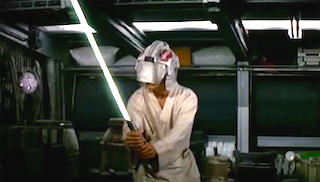 Here we see some of Joseph Campbell’s influences that were talked about in a previous post about Luke’s story and the influence of Campbell’s hero’s journey. As Christians, we can admit that Star Wars clearly is not a subversive attempt to explain away our beliefs, but it is also not a clear exposition of the Christian God. Lucas aims to make a catch-all spirituality that doesn’t explain away the supernatural, but give credence to its existence. That is something we can celebrate amidst the current trend of much more nihilistic, grim narratives of House of Cards, True Detective, and movies like There Will Be Blood, Inside Llewyn Davis, and The Dark Knight.
Here we see some of Joseph Campbell’s influences that were talked about in a previous post about Luke’s story and the influence of Campbell’s hero’s journey. As Christians, we can admit that Star Wars clearly is not a subversive attempt to explain away our beliefs, but it is also not a clear exposition of the Christian God. Lucas aims to make a catch-all spirituality that doesn’t explain away the supernatural, but give credence to its existence. That is something we can celebrate amidst the current trend of much more nihilistic, grim narratives of House of Cards, True Detective, and movies like There Will Be Blood, Inside Llewyn Davis, and The Dark Knight.
As an example, juxtapose the sincere, immediate belief of Luke Skywalker, the long-proven and stalwart faith of Darth Vader, and the specific disbelief/belief narrative arc of Han Solo. Vader has long been a pupil of the Force, both as a Jedi Knight and as a Dark Lord of the Sith. He chastises the high ranking officers on the Death Star for their faith in human technology instead of the all-powerful Force, and even chokes Admiral Motti to demonstrate its ability when Motti dares to retort back to Vader’s faithful assertion. Likewise, Skywalker quickly embraces belief in the Force and a higher power when instructed by Obi-Wan. His faith was even made sight when Obi-Wan tricked that Stormtrooper. He is a believer, despite having been a recent practitioner of the ways of a Jedi.
Conversely, when Han Solo is confronted with Luke’s youthful exuberance in the Force, as well as Obi-Wan’s staunch belief, he counters with a casual dismissal of anything supernatural.
“Kid, I’ve flown from one side of this galaxy to the other, and I’ve seen a lot of strange stuff, but I’ve never seen anything to make me believe that there’s one all-powerful Force controlling everything. ‘Cause no mystical energy field controls my destiny. It’s all a lot of simple tricks and nonsense.”
Solo embodies the modern skeptic and espouses a rewording of the common existential mantra, “I am the master of my fate.” The scoundrel, pirate, and smuggler requires little belief in anything that could take his hands off the proverbial wheel. His tools are luck, ingenuity, and a powerful blaster that shoots first. But for good measure, he makes sure to heap onto what he perceives is the believer’s folly by calling it “ancient” and “hokey”. The skeptical rogue is similar to Motti—the ardent believer in technological superiority—in their belief of religion and faith in the Force to be tantamount to “sad devotion” in an “ancient(aka dead) religion”.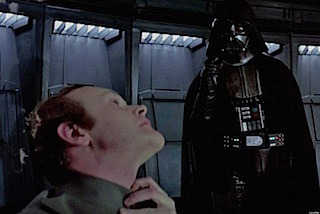
But Solo’s arc, unlike Motti’s abrupt and explosive force-guided proton torpedo end, ends with, at the most, a statement of belief, and at the very least a casual admission of the potential for belief. As he packs up to take his reward for the return of Leia, Luke tries to convince him to stay. After Han rebukes his “suicide” mission to attack the Death Star, Luke storms away only to receive the common blessing of the Rebel Alliance, “May the Force be with you.” While it more likely functions as an admission of mutual friendship than faithful profession, Han makes good on his declaration when he swoops in to wing Darth Vader’s TIE and clear the way for Luke to destroy the Empire’s “ultimate power”.
It is this power that the Imperials grasp at, but the lust for control and power will prove to be the most powerful—pun intended—metaphor for the Force. It’s right there in Vader’s warning to Motti. Vader warns him against trusting in the Death Star and that it is no match for the power of the Force. What makes the Empire and Darth Vader evil is not their mastery of a dark sorcery, but a lust for absolute power. And as the old adage says, “Absolute power corrupts absolutely.” It is this final point of power and the morality of the Force that I’ll turn to in the final article on a theology of the Force.
Until then, take a look back on the other parts in the series:


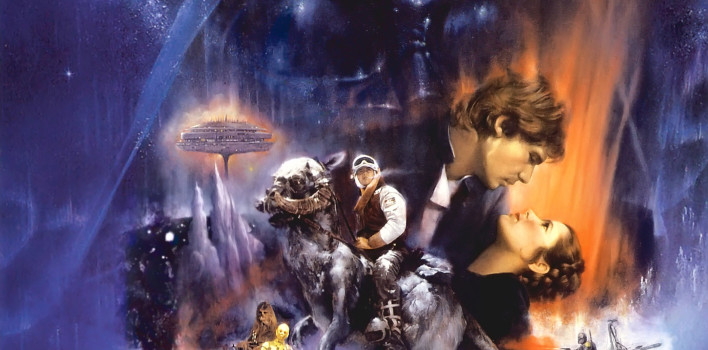

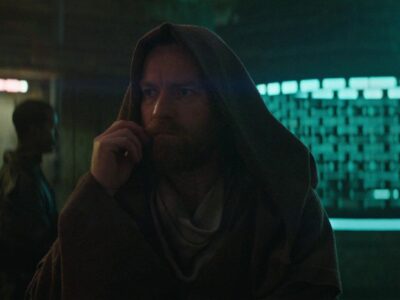
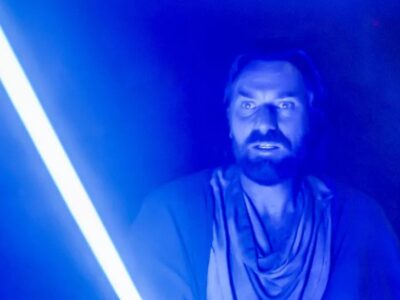


Pingback: A Theology of the Force – Part 3 | Reel World Theology
Pingback: A Theology of The Force Awakens Trailer | Reel World Theology